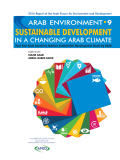The Urban Green Growth in Dynamic Asia project explores how to promote green growth in cities in Asia, examining policies and governance practices that encourage environmental sustainability and competitiveness in a rapidly expanding economy. This synthesis report presents the results of case studies along with practical policy recommendations, reflecting the local contexts of Southeast Asia. While Southeast Asian cities are affected by a range of economic, infrastructure, environmental and social challenges, ongoing rapid development offers opportunities to shift towards greener growth models. The concept of urban green growth can be a powerful vector of sustainable development, by emphasising the existence and potential of co-benefits between economic and environmental performance.

This AFED report on "Sustainable Development in a Changing Arab Climate" recommends an alternative approach, based on integrating sustainable development principles within the anticipated rebuilding efforts. It calls upon local, regional, and international aid organizations not to limit their efforts to providing safety and basic necessities to those affected, but rather to use the relief plans as a launch pad for promoting new approaches to development, rooted in a transition to green economy.
This report, on prospects and challenges on the path towards achieving the SDGs, builds on the previous eight reports on the state of Arab environment, produced by the Arab Forum for Environment and Development (AFED) since 2008. AFED annual reports have so far addressed major development issues in the Arab region, including Water, Food Security, Energy, Green Economy, Ecological Footprint, Sustainable Consumption, and Climate Change. The report highlights the policy options available for the Arab countries to realize the Sustainable Development Goals by the 2030 target set by the United Nations, in light of the new political, economic, and social developments.
History is replete with evidence that innovation can improve our lives in some circumstances and devastate them in others. The irony of our times is that as our economies become more and more service driven, we are producing, transporting, and consuming more resource- and energy-intensive material goods than ever before in ever more innovative ways. And herein lies the motivation for policy. Innovation can increase welfare, but only within socio-political environments that can respond creatively to its dual nature. Innovating is usually very hard to do, but sustaining human welfare through innovation is always even harder. Thus, for policy makers, the point is not just to increase the incidence of innovation but also to use it to leverage positive social outcomes. I propose that deploying innovation as a strategy for mitigating threats to the environment will demand that we get to grips with it from this perspective. Democracy is a public conversation about innovation, and in the Canadian case, achieving sustainability goals will be impossible unless public institutions are rehabilitated as agents of innovation.
This paper discusses the need for a Canadian clean innovation policy agenda to focus on organizational and institutional innovations within the public sector. The paper provides an introduction to innovation policy and how innovation can be directed to promote environmental sustainability. It then discusses the pitfalls that can lead to government failure in attempts to promote technological change. It then lists key institutional design principles to produce effective public-sector organizations capable of fruitfully engaging with the private sector to promote sustainability while avoiding the pitfalls discussed earlier. The article concludes by calling for further case-study research on how good institutional designs are achieved and what institutional designs best fit the Canadian context.
The paper explains the findings of the MC3 Project (Meeting the Climate Change Challenge). This project brought together over 100 researchers, practitioners, civil-society leaders, and policy-makers, led by researchers from Royal Roads University, Simon Fraser University, and the University of British Columbia, with 12 major research partners from the public and private sectors, including the Union of British Columbia municipalities. Researchers conducted a detailed evaluation of 11 leading, yet different, municipalities across the province to identify the leading innovators and innovations on climate action. The case studies revealed the following key drivers of innovation, in order of prominence: the legislative and policy framework, supported by provincially led incentives and tools, access to partnership funding and intermediary support, and framing the issue as critically important.
